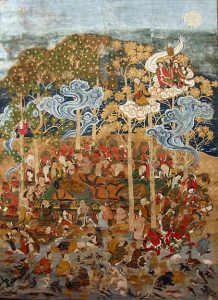18 Seven Dimensions of Religion in Buddhism
Narrative and Experience in Buddhism
Biographies of the Buddha
There were no complete biographies of the Buddha in the first 500 years after his death. Instead, followers preserved the Buddha’s teachings and lifestyle through the memorization of his talks, sutras, and the rules about conduct and attitude, or vinaya. These texts were initially memorized, not written down. Memorization was a characteristic of all Indian religions, not just Buddhism. It was considered to be the most reliable and accurate method because the text was preserved within a lineage of students and teachers who continually checked and corrected each other.
During his talks Sakyamuni Buddha told stories about his own life or former lives. These stories of his present and past lives appear throughout early scriptures. Complete biographies of the Buddha did not appear until centuries after the life of the Buddha, around 100 BCE to 100 CE. These full biographies were based on fragments found in the scriptures and on Jataka tales which tell stories about the Buddha’s former lives.
The shift to written texts meant that narratives could be more complicated and more literary. In addition, a biography could be written by a single person rather than taught in a community of people who had memorized the text. “Acts of the Buddha” by Asvaghosa is one important example of a single author’s biography of the Buddha. The following simple outline of the Buddha’s life combines various traditional Buddhist biographies, including material from Asvaghosa’s biography.
Becoming the Buddha: Siddartha’s Quest for the solution to suffering
Birth
The life story of the Buddha begins before he is born. Traditional accounts describe the bodhisattva as residing in heaven due to his good acts in previous lives. He looks down from heaven and chooses where he will be reborn and who his parents will be.
Traditional accounts of his birth include miraculous elements: he is born from his mother’s side as she leans against a tree. He is said to take seven steps and declare that this will be his last life. Seeing that their baby son appeared to be an extraordinary person, his parents brought him to a wise man for advice about how to raise him. The wise man predicted that if they could protect Siddartha from seeing suffering, namely sickness, old age, and death, then he would become a great and wise king. But if his eyes were opened to suffering, nothing could prevent him from becoming a Buddha, which means “awakened one”.
The idea that as a new-born baby Prince Siddartha showed extraordinary abilities to walk and speak is admired in many Buddhist cultures who attribute these abilities to many lifetimes of working toward complete enlightenment. His birth is honored by offerings of flowers and sweet tea in Japan on April 8 each year, considered to be his honorary birth day.
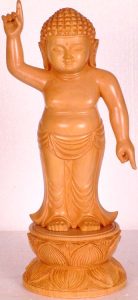
The Four Sights: Insight into Suffering
All went well throughout his youth. The young Siddartha became skilled at horse riding and archery, poetry and romance. He had everything he desired. And he lived exclusively at the palace, protected by his parents from seeing suffering.
But one day he decided to go into town. On that day he had his first encounter with a severely ill person. When he asked what was wrong with the person, his driver informed him that all beings can become ill. Siddartha was shocked, and it took quite a while for him to recover. Two more times he went into the town and saw an old person and a corpse. Each time he became upset and dismayed. Perhaps this seems strange that he would have been protected from seeing illness and death, but the point of the story is that he felt strong compassion and sadness over the suffering of the world when he saw these things. Ordinary people often pass by suffering and do not care until it touches them personally, but in his case, the sight of suffering itself affected him deeply.
On his fourth trip to town, Siddartha saw a calm, spiritual person. He wondered how the man had become so calm in the midst of suffering and resolved to achieve that calm himself.
The first three sights were disturbing, but gave him insight into suffering. The fourth sight was calming, and suggested a method for overcoming suffering. This pattern of calm and insight is characteristic of Buddhist meditation and ritual practices. This part of the biography emphasizes the importance in Buddhism of really seeing the suffering of the world, and yet being calm enough to do something about it.
The four sights are often depicted in buddhist art. This carving from the New Delhi museum shows the Prince Siddartha in his carriage seeing an old man leaning on a crutch.
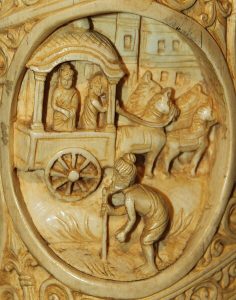
Leaving home to begin the Spiritual Search
The bodhisattva Siddartha resolved to leave home and become a wanderer, a sannyasin. He left his father’s palace, wearing his royal robes, and rode into the forest where he soon exchanged clothes with a hunter, shaved off his long hair and sent his horse back to the palace. This begins his search for the cause of suffering.
The bodhisattva Siddartha first practiced meditation based on yogic trances. He became good at meditation practices of withdrawing the mind from the senses and developing advanced states of calm. His teacher wanted him to take over teaching responsibilities. But the bodhisattva knew that these meditations had not brought him mental peace that lasted longer than the meditation itself. Each time that he withdrew from the meditation practice, he saw that his mind was not calm.
The bodhisattva Siddartha then tried practicing austerities, which are the extreme control of diet, sleep, and other physical needs. After a long period of fasting, he found that he still was no closer to discovering the cause of suffering. He was so weak that he was near death.
Buddhist art depicts this moment in Prince Siddartha’s search when his efforts to practice extreme self-control bring him near death. The following image shows his thin frame, depicting his own account that he could feel his spine through his thin body.
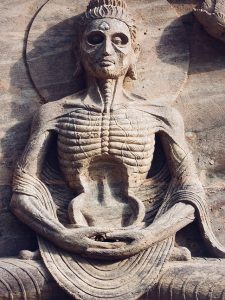
Discovering the Middle Way
At last the bodhisattva had the insight to realize that austerities and extreme mental practices in meditation did not solve the problem of suffering. These practices had failed to bring enlightenment and peace. Siddartha decided to take a meal, regain his strength, and continue his quest. This discovery is called the middle way: he learned that enlightenment does not come through extreme efforts, but by following a path of physical moderation and a balance between calm and insight.
There is a story that a young woman named Sujata offered Prince Siddartha a bowl of food at the very moment that he realized his efforts had failed. This nourishment gave him the strength to continue his spiritual journey.
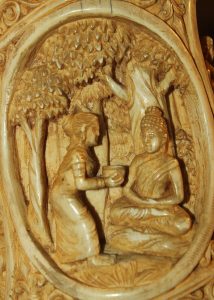
Enlightenment
Resolving to overcome suffering and the endless round of birth and death and rebirth, Siddartha sat in meditation under a tree. This time he used a peaceful meditation that combined calm with insight.
After long meditation and struggle with mental doubts and confusion, the bodhisattva at last achieved enlightenment or nirvana, going through 3 stages of awakening:
- First, he sees his own past lives: he gains knowledge of karma and result.
- Second, he sees the birth and death of other beings and realizes compassion for others.
- Third, he gains the knowledge of the Cause of Samsara: ignorance and grasping were destroyed.
The first two insights are the result of higher powers from meditation practice. These two kinds of knowledge were available to other highly developed meditators. These two accomplishments do not yet make him into a Buddha.
The third insight is the final enlightenment, nirvana. Nirvana means to blow out, to extinguish the afflictions. The two main causes of afflictions are ignorance of the cause of samsara and suffering; and grasping at things that are impermanent as if they were permanent. Nirvana means the absence of the two causes of ignorance and grasping.
This experience transforms the bodhisattva into a Buddha. The word Buddha is a title which means “awakened one”. He will not be reborn again because he has destroyed the karma (= intentional action) that would cause his rebirth (= result of intentional action). Although Westerners tend to think of the Buddha as a man who lived in a particular place and time, the Buddha pointed out that the quality of being a Buddha is not unique to him: there were other Buddhas before him and there will be others to come.
Decision to Teach
After his enlightenment, Sakyamuni Buddha continued to sit meditation for several weeks, confirming his insight into the nature of suffering and existence. At the end of this time, he doubted that anyone could understand what he had experienced and understood. Yet, thinking that there may be one person who would understand, he decided to teach. He soon met his old companions who asked what had happened to him. He then delivered his first sermon.
The first sermon describes the Middle Way and the Four Noble Truths. We have already learned about the Middle Way. The Four Noble truths are first, the fact that we suffer in life. Second, this suffering is caused by mental and physical grasping at impermanent things as if they were permanent. Third, there is an end to suffering. Fourth, there is a method called the Eightfold Path that is the means to ending suffering. The effect on his audience was immediate: one of his hearers became immediately aware of the Buddha’s insight and was able to see the world differently. This “proved” the power of the teaching to lead others to insight. We now have the Three Treasures of Buddhism: the Buddha, who was awakened to the causes of samsara; the Dharma, which conveys that insight into the cause of samsara; and the Sangha, which is the community of people who follow the Buddha and his teachings.
Parinirvana
After more than forty years of teaching, Sakyamuni Buddha reached the end of his natural life span. Since the Buddha has eliminated the causes of rebirth, Buddhists do not speak of the end of his life as his “death”. Instead, the Buddha enters parinirvana, which means the complete nirvana without rebirth. He will not be reborn again because he has accomplished his goal.
It looks as though “the Buddha” no longer exists, but Buddhists focus instead on his teachings, the Dharma. Since the characteristic of a Buddha is insight into truth, then preserving, practicing, and realizing this insight is the highest value in Buddhism. Art depictions of the parinirvana show the Buddha lying on his right side with his disciples and other followers gathered around. Since the Buddha’s enlightenment extends to all sentient creatures, heavenly beings and animals are also present at this special moment.
